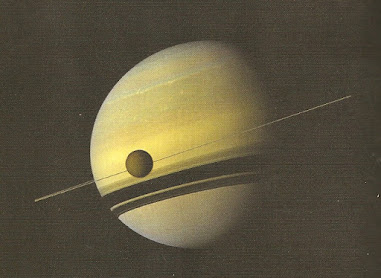A new paper shows Saturn's rings are the residue of moon called Chrysalis
For decades planetary astronomers have tried to solve the mystery of the origin for Saturn's rings. Now, a new paper in the Sept. 15 issue of Science, provides a coherent theory that an ancient Saturnian moon named Chrysalis has become the rings. Jack Wisdom (MIT Professor of Planetary Science) and his colleagues propose that tidal forces tore apart the unfortunate moon a mere 100 to 200 million years ago or so. The scenario could also explain Saturn’s axial tilt, and the somewhat elongated orbit of the planet’s largest moon, Titan.
In the words of Tracy Becker, a planetary scientist at the Southwest Research Insititute:
"It's always nice to find solutions that can elegantly explain multiple different observations."
Which is an understatement, and which lends Wisdom et al's theory enormous ballast.
Wisdom and his collaborators note that Saturn’s precession — the slow wobble of its spin axis — has almost, but not quite the same period as the precession of the orbit of Neptune. The researchers thus suggest there was once a true spin-orbit resonance between the two planets. Currently, that no longer exists given that there is roughly a 1 percent divergence. But the closeness suggested a hitherto unknown factor might account for the difference. And this turned out to be the moon Chrysalis, for which simulations disclosed that a Titan-Chrysalis resonance made the latter's orbit chaotic. That orbit was then "pumped" to higher and higher eccentricity drastically altering Chrysalis' distance from Saturn creating closer and closer encounters with the moons Titan and Iapetus.
Then about 100 My ago the exaggerated eccentricity caused Chrysalis to be ejected from the immediate original system causing it to get so close to Saturn that tidal forces ripped it apart - thereby forming the ring system we see today. Not surprisingly, as Chrysalis disintegrated and became the rings the once fine tuned resonance diminished until there is a one percent difference today - in the resonance between Neptune and Saturn.
Additionally, the relatively rapid drifting-away of Titan (which currently spirals outward at about 11 centimeters per year) might have lowered Saturn’s axial precession period until the resonance locked in hundreds of millions of years ago. That’s when Saturn’s spin axis started to tilt, possibly up to 36° at that time, according to the team’s calculations. Thus, the disintegration of the hypothesized moon Chrysalis to become the rings also led to the extraordinary tilt of Saturn's spin =axis.
Here we go a tad more "in the weeds": When
Titan drifted outward, Chrysalis became
trapped in a 3:1 resonance with Titan, orbiting Saturn once for every three
times Titan swung around. But the resonance didn’t last: Computer simulations by the Wisdom et al team show that the orbit of Chrysalis would have become chaotic, with the moon
experiencing a couple of close encounters with both Titan and Iapetus before
being ejected out of the Saturnian system, or ending up so close to the planet
that it was torn asunder by tidal forces. As was noted earlier.
The elimination of an icy moon (about as massive as Iapetus) would suddenly change Saturn’s precession period, diverging the planet from its spin-orbit resonance with Neptune. Saturn’s axial tilt (or obliquity) would start to decrease again (at present, it’s 26.7°). The earlier close encounters with Titan might explain this giant moon’s relatively high orbital eccentricity. And if Chrysalis was indeed ripped apart, Saturn’s impressive ring system is composed of its icy remains.
Alas, not all astronomers are buying into this scenario. Luke Dones (Southwest Research Institute, Boulder) says he is “impressed that Wisdom and his colleagues can reproduce both the obliquity of Saturn and Titan's eccentricity. It’s a clever idea.” But, he adds,
“They take for granted that the rings are young, which is not established. We don't know the dust impact rate on the rings, and we don't understand what happens when dust hits the rings at high velocities.”
But in my opinion this is nitpicking and doesn't do service to the other observed aspects the Wisdom theory can account for. In an accompanying commentary in Science, Maryame El Moutamid (Cornell University) describes the Chrysalis scenario as “a plausible mechanism for explaining Saturn’s close proximity to the precession resonance with Neptune and the seemingly young age of its rings.”
There are some details of the work that could be improved upon, of course. To estimate how much the computed moment of inertia depends on the assumptions, the Wisdom team used three additional approaches to construct models of the interior of Saturn. These models, however, only matched the gravitational moments J2, J4, and J6 without invoking differential rotation.
Wisdom admits also they "constructed interior models using four different sets of assumptions". For a range of rotation periods, the corresponding moments of inertia are shown in his paper's Fig. 1 in terms of the normalized angular momentum: the product of the moment of inertia and the rotation rate, normalized by:
M Re 2 Ö GM/ Re 3
where G is the gravitational constant, M is the mass of Saturn, and Re is its fiducial equatorial radius, taken to be 60,268 km
To see the full paper by Wisdom et al, including their resonance model and the actual hypothesized mechanisms, go to this link:
``Loss of a satellite could explain Saturn' obliquity and young rings''
See Also:

No comments:
Post a Comment